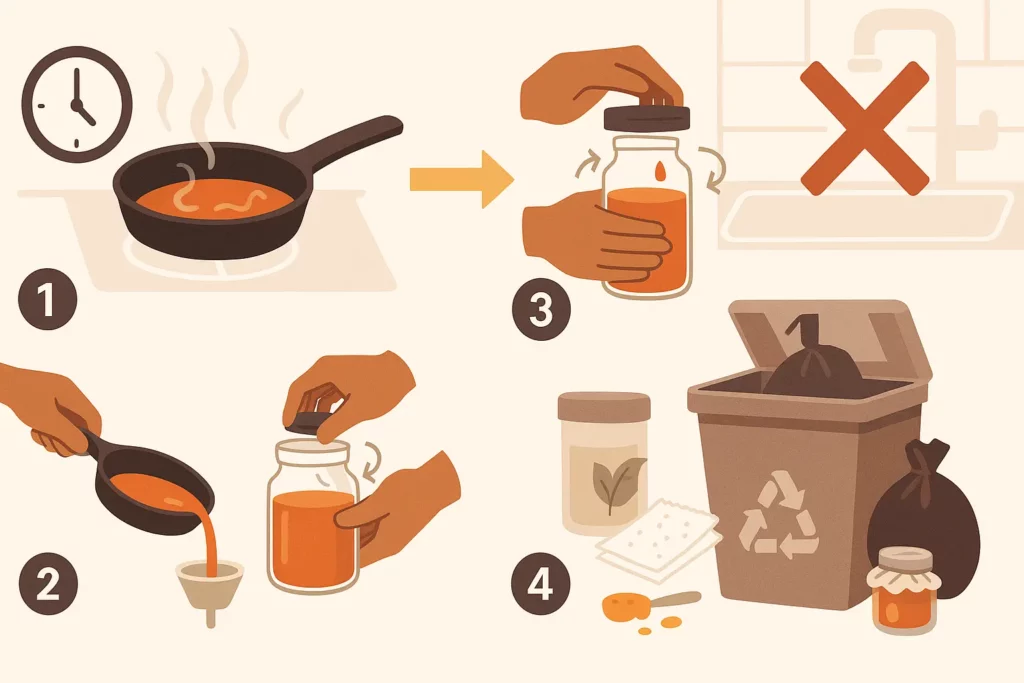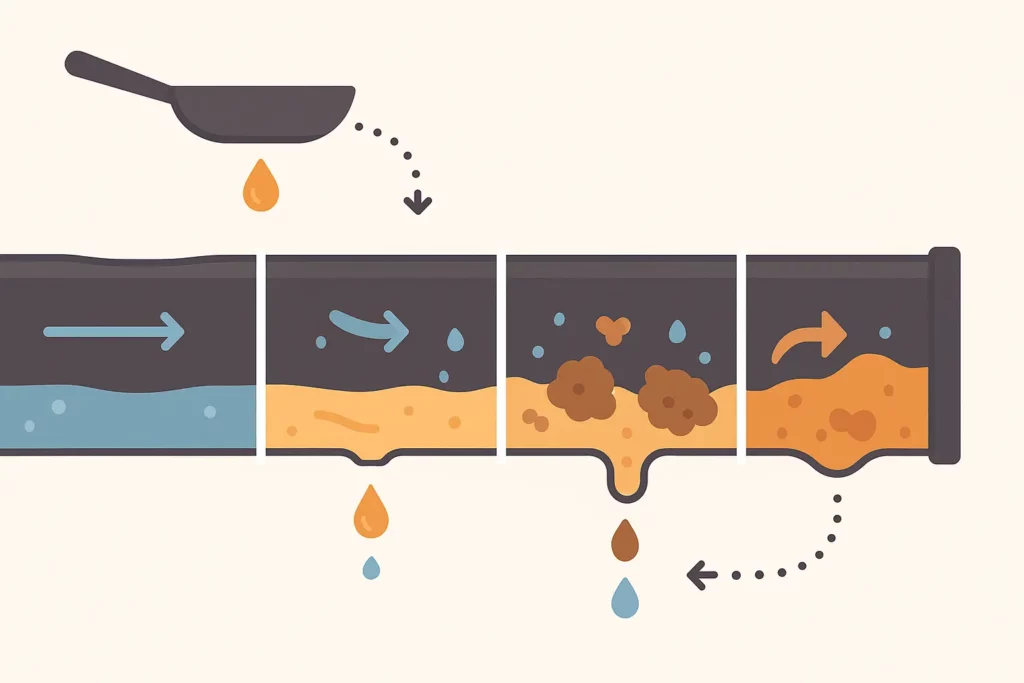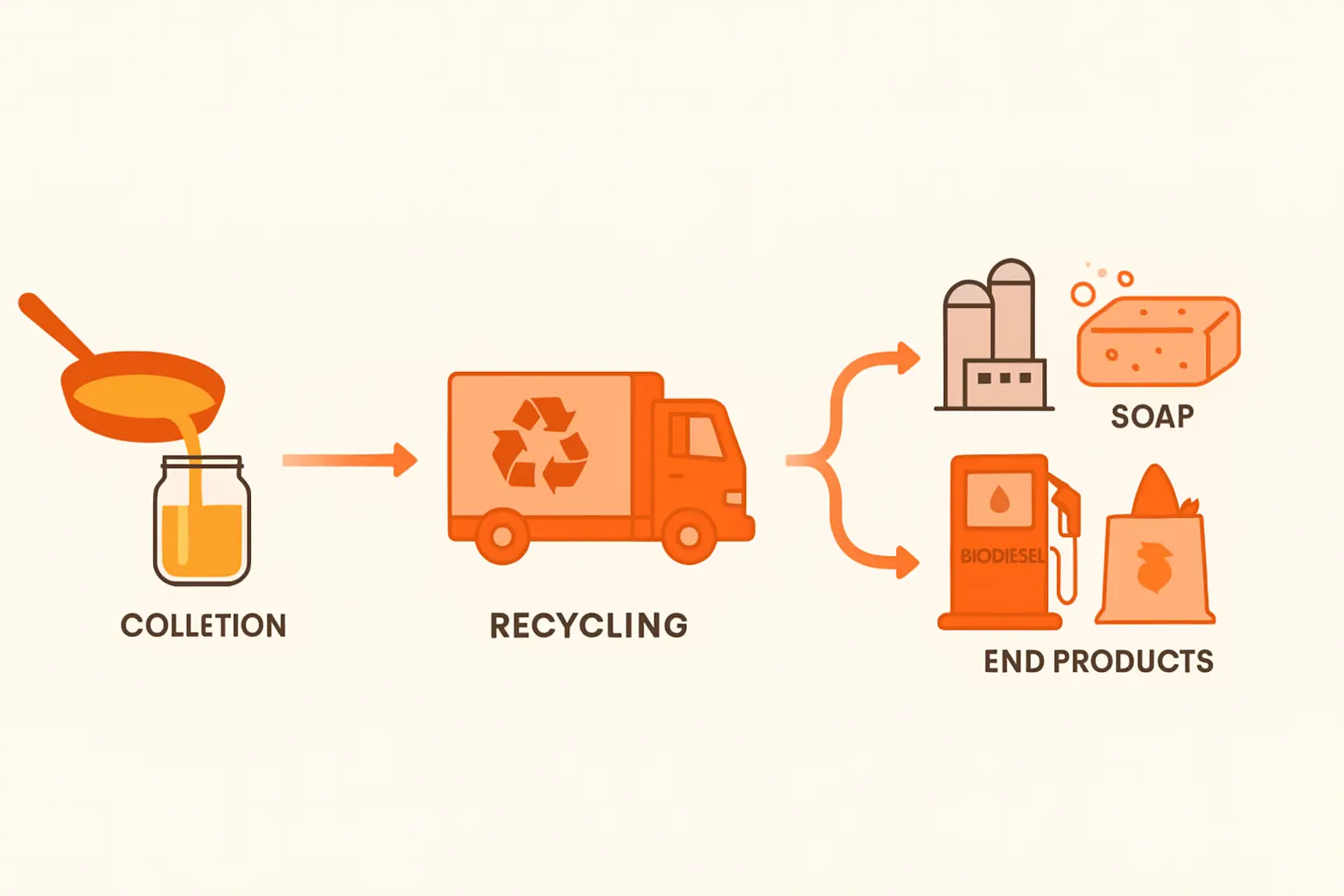That bacon grease in your pan could power delivery trucks—recycled cooking oil becomes biodiesel fuel. Will you trash it or transform it?
Jump to a question
- What do they do with recycled cooking oil?
- What happens to recycled used oil?
- How do I properly dispose of cooking oil at home?
- Can used cooking oil be reused?
- What creative DIY uses exist for used cooking oil?
- Why is pouring oil down the drain harmful?
- How long can I store used cooking oil before recycling?
- Complete used cooking oil recycling guide summary
What do they do with recycled cooking oil?
Recycled cooking oil still has plenty of life left. It’s turned into biodiesel, eco-friendly soaps, lubricants, and even animal-feed supplements.
Recycling starts when haulers pick up used oil from homes and restaurants. “We transform about 3 billion gallons of used cooking oil into biodiesel annually in the US alone,” says Jennifer Case, Technical Director at Clean Fuel Aliance (2023).
Once at processing facilities, the oil is pushed through micron filters to remove food particles and debris. Most of that clean oil transforms into biodiesel. In a process called transesterification—think high-tech soap-making—the fuel slashes tailpipe emissions by about 86% compared with regular diesel¹.
• Try This: Hold a jar of used oil up to light—if you can see through it after filtering, it’s clean enough for many DIY uses.
And that’s the beginning—fryer oil winds up in everyday products. Soap makers harness the fatty acids from vegetable oil—the same process used to create traditional lye soap. Factories infuse it into lubricants, swapping out petroleum. Cosmetic labs refine it again and spin it into lotions and hair conditioners—yes, the FDA still monitors the paperwork.
Even animal feed benefits from recycled cooking oil when it’s processed according to safety rules. Pet food manufacturers add processed oil to boost nutritional content, providing essential fatty acids. Nothing lands in the trash; even biodiesel glycerin shows up in cough syrup and face wash.
Takeaway: Transform old fryer oil into biodiesel cutting emissions 86%, creating eco-friendly soaps, lubricants, and animal supplements while preventing drain clogs costing $200–$5,000 in repairs.
What happens to recycled used oil?
After collection, waste oil is threaded through carbon filters during multiple stages of cleaning and processing to create biodiesel, industrial goods, or everyday consumer items. This transformation prevents water contamination while creating sustainable alternatives to petroleum products.
Step one is heating and filtration to strip out food particles and moisture. “The key is removing every trace of food debris—even tiny particles can contaminate an entire batch of biodiesel,” explains Marcus Rodriguez, Operations Manager at GreenFuel Recycling (2023). Next comes the chemistry—for biodiesel, that means mixing oil with methanol and a catalyst to forge fuel that powers vehicles and heating systems. This renewable fuel dramatically slashes emissions compared to fossil fuels.
• Try This: Pour a tablespoon of used oil into clear water—watch how it floats and resists mixing, showing why it needs special processing.
Here’s the wild part: that same oil can lubricate factory gears, light a camping lamp, or power an industrial cleaner. Consumer products range from natural soaps to leather conditioners and furniture polish. Even theme parks run some rides on biodiesel made from their own fryers’ oil.
Quality control ensures each product meets specific standards. Biodiesel must pass ASTM D6751 testing before entering fuel markets. Cosmetic-grade oil needs extra refinement to remove impurities and odors. Thanks to that extra care, the finished products often rival—or beat—anything made from crude oil.
McDonald’s Sweden faced 1,400 tons of waste oil annually, they partnered with biodiesel producers to create closed-loop system. Delivery trucks now run on French fry fuel, cutting 2,100 tons CO2/year, saved $1.2M in diesel costs

Mc Donalds
Takeaway: Waste oil morphs through heating and specialized filtration into premium biodiesel, industrial lubricants, and consumer products matching petroleum quality while creating sustainable alternatives.
How do I properly dispose of cooking oil at home?
Cool used cooking oil completely, pour it into a sealable container, then throw it in the trash. Tempted to pour hot grease down the sink? Skip it. Even small amounts cause expensive clogs and plumbing damage.

The golden rule: let oil cool first. Hot oil melts plastic—and burns skin. “I see about 20 grease-related calls per week, and most could’ve been prevented with proper disposal,” says Tom Chen, Master Plumber at Roto Rooter (2023). Once cooled, funnel the oil into any leak-proof container—an old jar, milk carton, or even a sturdy plastic bag. Seal it tight and toss it in the trash. For small amounts like half a cup or less, soak it up with paper towels and dispose of those instead.
• Try This: Freeze small amounts of oil in an ice cube tray lined with foil—pop out the frozen cubes into trash for mess-free disposal.
Find local recycling services for larger amounts or frequent disposal. Many communities offer cooking oil recycling drop-off points or collection events—NYC alone has 23 year-round drop sites². Some areas have curbside pickup for used oil—check with your waste management provider. Busy restaurants must use licensed waste oil collectors, but these services sometimes accept residential oil too. Learn more about commercial grease trap vs. interceptor requirements.
Ready for hassle-free pickup? Book a free Grease Connections pickup today and join thousands who’ve simplified their fryer oil recycling near me.
That quick pour can morph into a $200–$5,000 plumber visit³—and it gets pricier if the main line backs up. Installing a grease trap helps commercial kitchens, but home cooks should focus on proper disposal habits. Hot water and soap chase the grease farther down the line. Once it cools, it hardens. Garbage disposals can’t handle any amount of liquid oil.
Takeaway: Proper disposal in sealed containers prevents expensive plumbing disasters averaging $375 per basic grease clog, potentially reaching $5,000 for main line backups requiring emergency service.
Can used cooking oil be reused?
Yes, you can reuse cooking oil two to three times if you filter it properly, or repurpose it indefinitely for household tasks like lubricating hinges, protecting garden tools, and making homemade soap.
For cooking purposes, strain used oil through a coffee filter or cheesecloth to capture food particles. Store the filtered oil in a clean, sealed container away from light and heat. “Restaurant-quality oil can handle three frying cycles if you maintain temps below 375°F (191°C) and filter between uses,” notes Sarah Kim, Executive Chef at Blue Mountain Bistro (2023). Frying oil stays usable for two or three rounds—toss it when you notice: dark color, thick consistency, rancid smell, or smoking at lower temperatures. Deep fryer oil in commercial kitchens follows similar guidelines but with stricter monitoring per USDA FSIS guidelines on fats.
• Try This: Drop a small piece of white bread into reused oil—if it browns evenly in 50–60 seconds, the oil’s still good for frying.
After frying, the oil remains handy around the house. As a lubricant, it silences squeaking hinges, frees stuck locks, and keeps lawnmower blades running smoothly. Garden tools coated with old oil resist rust and prevent soil buildup while shielding metal from corrosion.
Creative reuses multiply: mix equal parts oil and vinegar for wood furniture polish. If wicker looks dry, buff on a thin coat. During power outages, vegetable oil fuels emergency lamps. Some even use filtered oil as a cleaner to extract tar and tough dirt from vehicles.
Takeaway: Properly filtered cooking oil extends life 2–3 frying cycles, saving $20–30 monthly while repurposed oil replaces $50–100 in household lubricants, polishes, and rust preventers annually.
What creative DIY uses exist for used cooking oil?
Transform used cooking oil into homemade soap, emergency lamp fuel, furniture polish, or garden tool protector. These DIY projects give old oil new life while saving money on household products.

Soap making tops the list of popular DIY projects. Old-school lye soap starts with vegetable oil. “Used cooking oil makes better soap than fresh—the free fatty acids from frying jumpstart saponification,” explains Jessica Martinez, founder of Heritage Soap Works (2023). Mix filtered used oil with lye (sodium hydroxide) and water. The chemical reaction creates natural soap perfect for household cleaning. Add essential oils to improve scent. When working with lye, always wear gloves and goggles, and add the lye to water—never the other way around.
• Try This: Test oil for soap-making by mixing 1 tablespoon oil with 1 teaspoon lye solution—good oil will thicken within minutes.
For emergency preparedness, filtered cooking oil works as fuel in hurricane lamps or DIY oil lamps. Pour clean oil into the lamp reservoir and use a cotton wick. During power outages, this provides hours of light. Oil-soaked rags make excellent fire-starters—stash them in a sealed metal can until needed.
Garden and workshop applications flourish. Create a rust protector by coating cast iron with oil. Mix oil with bird seed to make winter bird feeder treats that provide extra calories for cold weather. Skip dumping oil into compost—the fats smother microbes and attract pests. For leather goods, work oil into a soft cloth to craft an effective preservative that keeps items supple.
Takeaway: Convert waste cooking oil into valuable household products like soap, emergency lamp fuel, and rust protector, potentially saving homeowners $50–100 yearly on commercial alternatives.
Why is pouring oil down the drain harmful?
Pouring cooking oil down drains causes it to solidify and cling to pipes, creating blockages that lead to sewage backups, burst pipes, and repairs costing $200–$5,000. Oil also forms massive ‘fatbergs’ in city sewers.
The science is simple but harsh: liquid oil cools and solidifies inside pipes like cholesterol in arteries. Even small amounts accumulate over time, trapping food particles and other debris. “We pulled a 40-foot fatberg from the downtown interceptor last month—took three days and cost taxpayers $85,000,” reveals Patricia Wong, San Francisco Public Works FOG Program Manager (2023).
• Try This: Pour hot bacon grease into a clear glass with ice water—watch it instantly solidify to see what happens in your pipes.
What happens in your pipes

This creates complete blockages that trigger wastewater to back up into your home. Repeated disposal compounds the problem, eventually causing pipes to rupture from pressure buildup.
Municipal sewer systems suffer even worse consequences. Cooking oil combines with calcium in wastewater to form soap-like compounds that cement to sewer walls. These merge with wet wipes, congealed grease from restaurants, and other waste to create fatbergs—some longer than a city bus. London’s Thames Water reported removing a 250-meter fatberg in 2021—heavier than 19 elephants—that took nine weeks to clear⁴.
Using hot water or garbage disposals doesn’t help—it drives the sludge downstream where oil still solidifies. Dish soap buys you a few extra feet. It can’t prevent oil from hardening later. The environmental impact extends beyond plumbing: oil entering water systems through storm drains decimates aquatic life and contaminates water sources. Many cities now fine residents for improper oil disposal, with EPA-regulated municipalities issuing penalties from $250–$10,000⁵. View EPA’s FOG control program guidelines.
Myth-Buster: Oil Disposal Edition
| Myth ❌ | Truth ✓ | Why It Matters | Source |
|---|---|---|---|
| “Hot water prevents oil from hardening” | Hot water cools within 10 feet of pipes | Oil solidifies anyway, causing clogs deeper in system ($500+ repairs) | IAPMO 2023⁶ |
| “Garbage disposals can handle liquid oil” | Disposals spread oil onto pipe walls | Creates wider coating area, faster buildup (clogs in 3–6 months) | EPA 2023⁷ |
| “Small amounts don’t matter” | 1 cup can coat 50+ feet of pipe | Accumulates with neighbors’ oil, forming neighborhood blockages | NACWA 2023⁸ |
Takeaway: Every cup of oil poured down drains solidifies within minutes, potentially triggering $4,500 average emergency plumbing repairs plus contributing to million-dollar municipal fatberg removal costs.
How long can I store used cooking oil before recycling?
Wondering how long that jar can sit? About a month, tops. Beyond that, oil develops rancidity, unpleasant odors, and potentially harmful bacteria.
Proper storage extends oil life while you await recycling. After straining out food particles with paper towels or filters, funnel cooled oil into clean, airtight containers. “We recommend the 3-3-3 rule: 3 weeks at room temp, 3 months in the fridge, or 3 hours if contaminated with meat particles,” advises Dr. Rachel Park, Food Safety Extension Specialist at UC Davis (2023). A mason jar or rinsed peanut-butter tub both work perfectly. Label with the date and oil type—vegetable oil keeps longer than animal-based oils, which go rancid faster. Keep containers in a cool, dark place like a pantry or garage.
• Try This: Write the storage date on masking tape with a Sharpie—stick it on your oil container to track freshness at a glance.
Commercial kitchens with deep fryers often have larger storage systems, holding oil until recycling services arrive. Companies like Restaurant Technologies and DAR PRO Solutions recommend that home cooks avoid storing oil longer than four weeks as it develops increasingly strong odors and can attract pests. If oil smells sour, looks cloudy, or shows any mold growth, dispose of it immediately rather than recycling—contaminated oil can’t be processed into quality products.
Visual Timeline: Oil Storage Life
- Day 1–7: Crystal clear, minimal odor
- Week 1–2: Slight cloudiness, faint smell
- Week 2–4: Noticeable odor, darker color
- Week 4+: Rancid smell, possible mold—disposal necessary
Hot summers shrink that window to two weeks; a chilly garage extends it slightly. Winter allows marginally longer storage, but freezing can crack containers. For those producing large amounts regularly, schedule quicker pickup instead of letting oil pile up.
Takeaway: Store properly filtered cooking oil maximum 4 weeks at 65–70°F before recycling, preventing rancidity that makes oil unsuitable for biodiesel processing worth $0.50–$1.00 per gallon rebates.
Complete used cooking oil recycling guide summary
That pooling grease from breakfast has traveled quite a journey—from potential drain-clogger to biodiesel powering delivery trucks. At Grease Connections, we’ve spent over 25 years perfecting cooking oil recycling, processing millions of gallons annually across the Southeast.
Recycling transforms your fryer oil into low-carbon biodiesel, factory lubes, handmade soaps, and animal feed supplements. The process involves certified haulers collecting oil, multi-stage filtration removing contaminants, and advanced processing creating valuable products. In 2023, US recycling prevented 18 million tons of CO2 emissions—equivalent to removing 3.8 million cars from roads⁹.
Never pour oil down drains—it solidifies into expensive blockages and fatbergs. Disposal errors cost homeowners $2,850 on average¹⁰ while cities spend millions on sewer maintenance. Instead, cool oil completely, seal in containers, and use trash disposal or recycling services. Over 3,000 communities offer drop-off programs. Grease Connections operates 47 sites accepting residential and commercial oil.
Before disposal, consider reusing filtered oil 2–3 times for frying or indefinitely for household tasks—lubricating hinges, protecting tools, making soap. Store oil maximum four weeks in cool, dark places. I learned proper storage firsthand managing restaurant kitchens, saving $300 monthly.
Proper recycling benefits everyone. Restaurants save 15–20% on waste costs while earning oil rebates. Homeowners prevent plumbing disasters. Cities avoid infrastructure damage—Atlanta spent $4.2 million clearing fatbergs in 2022¹¹. The biodiesel industry creates jobs while supporting energy independence.
Join 50,000+ readers protecting their pipes. Bookmark this guide—or share it with someone still pouring grease down drains.
Find your local oil drop-off locations (interactive map) →
Note: External links are provided for informational purposes and are not endorsements.
Written by Jorge Argota, Co Founder of Grease Connections and running commercial kitchens and grease programs.
Disclaimer: This guide provides general information and is not a substitute for professional plumbing advice. Always consult licensed professionals for specific plumbing issues or commercial waste oil management requirements.
Sources
- EPA. “Biodiesel Emissions Analysis Program.” Environmental Protection Agency, 2023. https://www.epa.gov/fuels-registration-reporting-and-compliance-help
- NYC Department of Environmental Protection. “Cooking Oil Drop-Off Locations.” NYC DEP, 2023. https://portal.311.nyc.gov/article/?kanumber=KA-02662
- HomeAdvisor. “How Much Does Drain Cleaning Cost?” HomeAdvisor Cost Guide, 2023. https://www.homeadvisor.com/cost/plumbing/
- Thames Water. “Fighting Fatbergs: Annual FOG Report.” Thames Water UK, 2021. https://www.thameswater.co.uk/about-us/environment/sustainability
- EPA. “National Pretreatment Program: Controlling Fats, Oils, and Grease.” Environmental Protection Agency, 2023. https://www.epa.gov/npdes/national-pretreatment-program
- International Association of Plumbing and Mechanical Officials. “FOG Control Guidelines.” IAPMO, 2023. https://www.iapmo.org
- EPA. “Pretreatment Standards and Limits.” Environmental Protection Agency, 2023. https://www.epa.gov/npdes/national-pretreatment-program
- National Association of Clean Water Agencies. “FOG Management Best Practices.” NACWA, 2023. https://www.nacwa.org
- National Biodiesel Board. “Biodiesel Environmental Benefits Report.” NBB, 2023. https://cleanfuels.org/
- Angi. “National Plumbing Repair Cost Report.” Angi Services, 2025. https://www.angi.com/articles/cost-to-repair-leaking-pipe.htm
- City of Atlanta Department of Watershed Management. “Annual FOG Program Report.” Atlanta DWM, 2022. https://www.atlantaga.gov/government/departments/watershed-management









